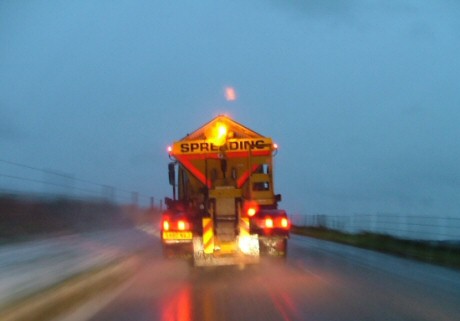How do we grit the roads?
We use crushed rock salt to melt ice or prevent it from forming on the roads and this is spread onto the road using six purpose-built gritters. The spreaders at the rear of the gritters are designed to give an even distribution of salt across the road and spread the salt at a controlled rate. We aim to get salt onto the road surface before the ice is expected to form or snow to fall; this is known as precautionary salting.
Ideally the gritters set-off before ice or snow is expected, with each one taking two hours to complete its route. Every effort is made to avoid the need to treat roads during peak traffic periods, as the gritters can become delayed in traffic and can get stuck along with the cars, buses and lorries they are trying to help.
How does salt work?
Salt is used to prevent ice forming; it does this by reducing the freezing point of moisture already on the road surface. The efficiency of salt becomes less as road temperatures fall towards minus 7ºC and below minus 10ºC salting is almost ineffective. Salt is not immediately effective when spread on top of ice and snow, but becomes more effective when traffic has crushed and circulated the salt over the road surface.
How can I find out exactly which roads are gritted?
You can find the precautionary road gritting routes in the winter section of the website.
Why do I rarely see a gritter on Hounslow’s roads?
Gritting frequently takes place late at night or very early in the morning and is timed to ensure the whole gritting network is treated before we think that ice might form on the road. As far as possible, we try to avoid gritting during rush hour periods.
Why aren’t all the roads gritted?
We can’t grit the borough’s entire 259 miles of road network because of the time it would take and the cost involved. Our normal six gritting routes cover 82 miles.
Who grits the trunk roads in the borough?
We grit some of the trunk roads in and around the borough. However, certain roads are not our responsibility. The roads below are managed by Transport for London (TfL):
- A4 (Bath Road, Great West Road, Cedars Road, Ellesmere Road, Hogarth Lane, Great Chertsey Road)
- A30 (Great South West Road)
- A406 (Gunnersbury Avenue)
- A205 (Kew Bridge Road)
- A312 (The Parkway, The Causeway, Faggs Road, Harlington Road West, Harlington Road East, Uxbridge Road, Hampton Road West)
- A316 (Country Way, Great Chertsey, Alexandra Avenue, Burlington Lane)
The M4 and M25 are treated by the Highways Agency.
If you believe that a road we treat has not been gritted, please contact us.
Who makes the decision to grit the roads and how?
Throughout the winter season, between 14 November and 11 March, we operate a winter service duty rota that provides 24/7 cover to monitor weather conditions and make appropriate decisions. We interpret information provided by a specialist winter weather forecasting bureau that provides forecasts throughout the winter season. The forecasts, which come four times every day, give predictions of the possibility of freezing road temperatures or snow, and the time those conditions may occur.
Can I ask for a road to be added to the precautionary gritting network?
The schedule of treated roads has been developed over a number of years and is reviewed annually. Any requests for additional roads will be considered during the end of season review. No routes can be added to the schedule during the current winter season.
What happens when snow is on its way?
When snow is forecast salt is spread on the roads to slow the rate of snow settling, however much more salt is needed than when spreading salt to prevent ice forming. When snow fall reaches a certain rate salt can no longer prevent it from accumulating. In a built up area like Hounslow, it is not practicable to use snow ploughs to clear snow from the roads as there is too much traffic, too many parked cars and no space to push the snow. We will continue to spread salt on top of the snow, which does make it melt more quickly.
My road is very icy – can you send someone immediately to salt it?
Any requests are subject to route priority, prevailing conditions and available resources. Unfortunately, as we are inundated with such requests on a daily basis during severe weather, it is unlikely that we would be able to meet the additional demand.
Why do we only grit pavements in the town centre?
Widespread footway gritting is labour intensive and is not automatically done. We will only grit pavements at certain locations such as bus stops, tube stations and at the main entrance to schools and hospitals. It takes considerable time to do this and ice or frost lasting only for short periods cannot be treated in time before temperatures rise enough to melt naturally. Only where persistent snow appears do we endeavour to grit pavements on a reactive basis. With nearly 500 miles of pavements in Hounslow, salting every single one is simply not feasible – our efforts have to be concentrated on areas that will benefit the most people.
Do we provide grit bins?
Unfortunately we cannot provide grit bins.
Do we supply salt to the public?
We cannot supply individuals with salt. Local builders’ merchants, hardware stores and other suppliers usually sell rock salt for private use. Calcium chloride and sodium chloride salt may also be used.


